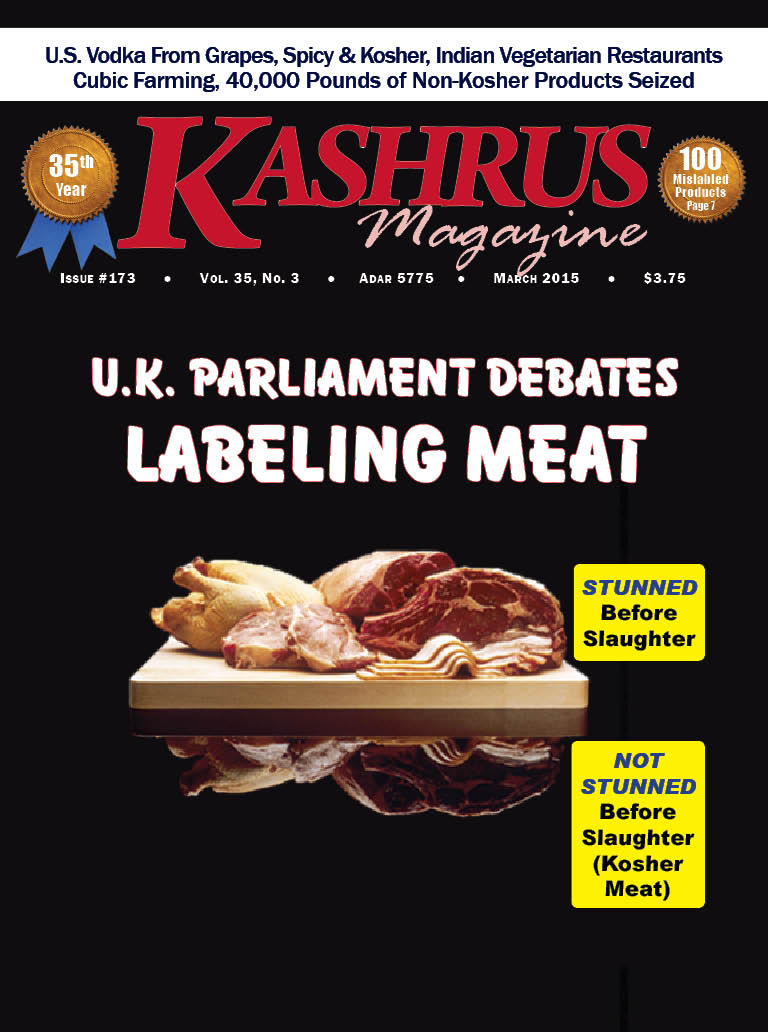
The Online Source For Kosher Information
 |
The Online Source For Kosher Information |
| HOME | • | KASHRUS Magazine | • | Kosher Alerts | • | Advertiser Services | • | Subscriber Services | • | Subscribe | • | Contact Us |
| KASHRUS MAGAZINE | |||
|---|---|---|---|
|
March 2015 U.K. Parliament Debates Labeling Meat |
|||

|
|||
| Plus: U.S. Vodka From Grapes, Spicy & Kosher, Indian Vegetarian Restaurants, Cubic Farming, 40,000 Pounds of Non-Kosher Products Seized | |||
|
Shechita and Stunning: Debate in the House of Commons Of the British Parliament - Exactly one year ago, KASHRUS Magazine featured “The Big Shechita Debate in the British Parliament” (March 2014 p. 36). That debate took place on January 16, 2014 in the House of Lords, the second chamber of the UK Parliament, and referred to in this debate as “the other place.” This debate took place in November 4, 2014 in the House of Commons. There is great concern that this spring the UK will begin to label meat as stunned or un-stunned. This could have major economic consequences for Jews all parts of the United Kingdom as sources to sell the hindquarters and meat which becomes un-kosher during shechita (neveilah) dry up. What follows is a digest of the presentations. For the complete debate go to http://tinyurl.com/n8lonrs. Animal Slaughter (Religious Methods) Mr. Philip Hollobone in the Chair November 4, 2014 Neil Parish (Tiverton and Honiton, Conservative) When the all-party group on beef and lamb, of which I am honored to be the chairman, decided to conduct an inquiry into the welfare of animals slaughtered in accordance with religious rites, I knew we were entering a highly polarized and often poorly understood area of public discourse. Discussions in the media have often produced more heat than light, and I hope the group’s report and today’s debate will provide more of the latter. Throughout the inquiry, we were careful to make distinctions between halal and shechita, the different methods of non-stun slaughter and the species being considered. We took evidence, in writing and in oral evidence sessions, from a wide range of stakeholders, including industry experts, Shechita UK, the Halal Food Authority, veterinary professionals, the Minister and the European Commission. European law requires that all animals are stunned before slaughter. However, a derogation permits member states to allow non-stunning in the case of slaughter in observance with religious beliefs. That is an important point. By law, animals have to be stunned before slaughter to ensure they suffer as little pain as possible, and the relevant laws were informed by scientific and veterinary evidence. Halal and shechita methods of slaughter are exempt from those scientifically established regulations not because they meet a different set of animal welfare standards, but because they are a matter of freedom of religious and cultural expression. In an ideal world, I would like all livestock to be stunned before slaughter, but that must be reconciled with the United Kingdom’s proud record of religious tolerance and our history of allowing communities to eat meat prepared in accordance with their faith. About 90% of lambs and 88% of chickens slaughtered under halal are stunned before slaughter, so the likelihood and duration of pain at the time of slaughter is likely to be much less. However, that still leaves a large number of animals that are not stunned before slaughter. It is estimated that 3% of cattle, 10% of sheep and goats, and 4% of poultry slaughtered in Great Britain are not pre-stunned. One estimate is that 114 million animals are killed annually in the UK using the halal method, while a further 2.1 million are killed under the shechita method. The value of the halal market is estimated at between £1 billion and £2 billion. Being able to prove that the stun is recoverable and will not kill the animal, but will instead render it insensitive to pain, is vital if we are to increase the number of animals stunned before slaughter. Some witnesses we took evidence from will accept no stunning during the slaughtering process, while others, including the Halal Food Authority, will permit some, but not all, methods of stunning. We took evidence, for example, on the use of post-cut stunning—stunning immediately after the animal’s neck is cut. Although it is not as desirable as pre-stunning, evidence from studies in New Zealand shows that post-cut stunning reduces the duration of pain at the time of slaughter, while ensuing that the cause of death is bleed-out, making this method of stunning halal-compliant. The inquiry highlighted that the majority of studies have been about halal slaughter. There is therefore a deficit in our veterinary understanding of the shechita method of slaughter in the Jewish community, which permits no form of stunning. In its evidence, the Department for Environment, Food and Rural Affairs said it had sought to include the shechita method of slaughter in its studies, but that it had not yet been successful in doing so. I therefore urge the Government to carry on that work and to look at the shechita method. To see the rest of this article, click “Buy This Issue Now” or “Subscribe” at the bottom of this page. |
|||
Copyright © 2000 - 2025 KASHRUS Magazine. | Webmaster | Subscribe |
| All rights reserved. No part of this document may be reproduced, photocopied, stored on a retrieval system, or transmitted without the express written consent of the publisher or the authors. |